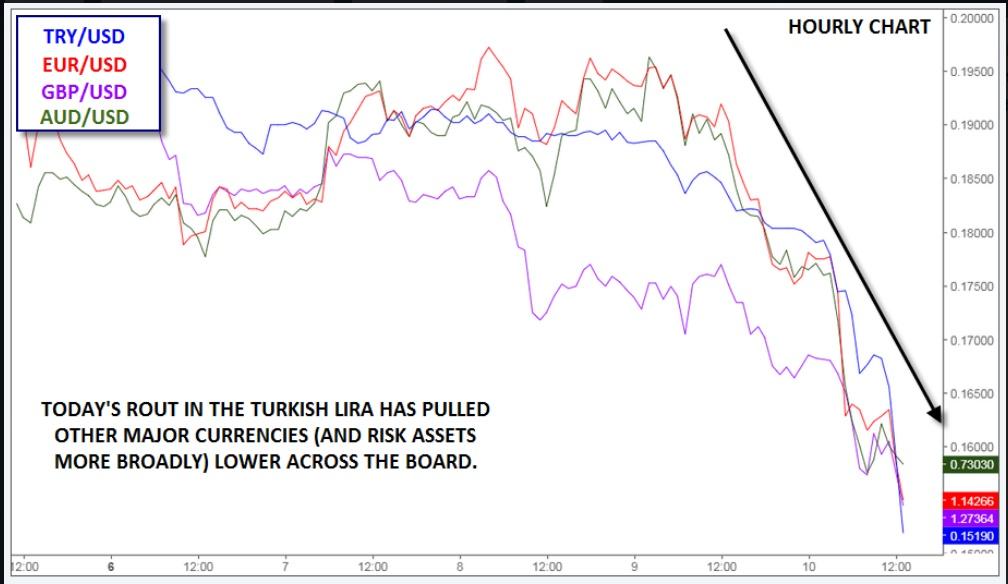The economic situation in Turkey has been a powder keg for months, and it’s finally found a spark.
While investors have never truly trusted Turkish President Recep Tayyip Erdogan, he’s shredded his last vestiges of credibility in recent months by appointing his son-in-law as the country’s finance minister and espousing his belief that lower interest rates were needed to fight inflation, the exact opposite of economic orthodoxy (and your humble author would argue, all the empirical evidence of centuries of central banking); indeed, Erdogan recently “interest rates are the mother and father of all evil."
At first glance, Turkey’s economy appears to be doing alright. After all, the country’s GDP grew by 7% in 2017 and appears on track to match that growth this year. The issue, as hinted above, is that inflation is running rampant at about 16%. With price pressures running hot, traders had expected the Central Bank of the Republic of Turkey (CBRT) to hike interest rates from their current 17.75% level in last month’s meeting. In defiance of investors’ and economists’ expectations, the CBRT instead held interest rates steady, sparking a selloff in the Turkish lira (TRY).
That selloff has turned into a rout this week after the US threatened (and has now instituted) punishing sanctions on senior Turkish ministers, as well as this morning’s announcement of steep tariffs on metals. The ferocity of the selloff in the lira is a true rarity among developed countries: Turkey’s currency has fallen by a staggering 16% today, 25% this week, and 42% year-to-date against the US dollar! With emotions ruling the market and volatility in the stratosphere, there’s no telling how far the currency could fall in the coming days and weeks.
Reminiscent of the European debt crisis of 2010 and 2011, investors are now turning their attention to the next domino to fall. According to the ECB, there are three European banks with heavy exposure to Turkey (BBVA, Unicredit, and BNP), and all of them are selling off sharply as a result.
More broadly, the situation has put a damper in risk appetite across global markets, with European stock markets selling off by 1-2%, US stocks trading lower at the open, and EUR/USD hitting a 1-year low. At least for the day, the investors’ focus has shifted from return on capital to return of capital, and as a result, we’re seeing a bid emerge for traditional “safe haven” assets, including Treasury bonds, the US dollar and the Japanese yen.
This research is for informational purposes and should not be construed as personal advice. Trading any financial market involves risk. Trading on leverage involves risk of losses greater than deposits.
Recommended Content
Editors’ Picks
EUR/USD edges lower toward 1.0700 post-US PCE

EUR/USD stays under modest bearish pressure but manages to hold above 1.0700 in the American session on Friday. The US Dollar (USD) gathers strength against its rivals after the stronger-than-forecast PCE inflation data, not allowing the pair to gain traction.
GBP/USD retreats to 1.2500 on renewed USD strength

GBP/USD lost its traction and turned negative on the day near 1.2500. Following the stronger-than-expected PCE inflation readings from the US, the USD stays resilient and makes it difficult for the pair to gather recovery momentum.
Gold struggles to hold above $2,350 following US inflation

Gold turned south and declined toward $2,340, erasing a large portion of its daily gains, as the USD benefited from PCE inflation data. The benchmark 10-year US yield, however, stays in negative territory and helps XAU/USD limit its losses.
Bitcoin Weekly Forecast: BTC’s next breakout could propel it to $80,000 Premium

Bitcoin’s recent price consolidation could be nearing its end as technical indicators and on-chain metrics suggest a potential upward breakout. However, this move would not be straightforward and could punish impatient investors.
Week ahead – Hawkish risk as Fed and NFP on tap, Eurozone data eyed too

Fed meets on Wednesday as US inflation stays elevated. Will Friday’s jobs report bring relief or more angst for the markets? Eurozone flash GDP and CPI numbers in focus for the Euro.
